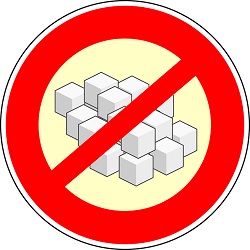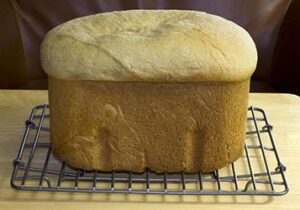 Well, folks—the old A1C has done its number on me again, reaching 6.3. If you’ve followed this blog for any length of time you know all about my struggles to keep that insidious number at a level below what is considered full-blown diabetes, 6.5. The A1C number is the percentage of your red blood cells that have glucose molecules attached to them. People with diabetic tendencies have higher blood-sugar levels than normal due to a condition known as insulin resistance. You may remember my striking analogy using the idea of a key (insulin) and a lock (on the door to the cell). A person with insulin resistance has cell locks that are hard to turn, needing a good strong key. (Hmmm. This analogy is already going off the rails.) In other words, more insulin than normal is needed to get the glucose out of the bloodstream and into the cells where it can be broken down (“burned”) for energy. Since excess sugar in the bloodstream is toxic, the best thing a diabetes-prone person can do is to avoid much in the way of sugar and other refined carbs in his or her diet. If blood sugar levels are kept stable and relatively low, the pancreas doesn’t get called upon to produce big surges of insulin to deal with the glucose spikes typically caused by ingestion of such foods.
Well, folks—the old A1C has done its number on me again, reaching 6.3. If you’ve followed this blog for any length of time you know all about my struggles to keep that insidious number at a level below what is considered full-blown diabetes, 6.5. The A1C number is the percentage of your red blood cells that have glucose molecules attached to them. People with diabetic tendencies have higher blood-sugar levels than normal due to a condition known as insulin resistance. You may remember my striking analogy using the idea of a key (insulin) and a lock (on the door to the cell). A person with insulin resistance has cell locks that are hard to turn, needing a good strong key. (Hmmm. This analogy is already going off the rails.) In other words, more insulin than normal is needed to get the glucose out of the bloodstream and into the cells where it can be broken down (“burned”) for energy. Since excess sugar in the bloodstream is toxic, the best thing a diabetes-prone person can do is to avoid much in the way of sugar and other refined carbs in his or her diet. If blood sugar levels are kept stable and relatively low, the pancreas doesn’t get called upon to produce big surges of insulin to deal with the glucose spikes typically caused by ingestion of such foods.
sugar
Eat Meals, Not Snacks

Small changes can make a big difference in your weight and health, as I keep a-sayin’ and a-sayin.’ Here’s a great small change you can make:
STOP BUYING SNACKS.
As I’ve said before, you can exercise three seconds of self-control as you pass by the cookie aisle, or the candy aisle, or the “salty snacks” aisle, and just refuse to go down into that valley of temptation, or you can bring junky stuff home and then have to resist it every time you walk by the pantry or the bowl on the coffee table. Just don’t buy it in the first place! In fact, here’s the question you should ask yourself whenever you see a bag or box that attracts your attention:
CAN THIS ITEM BE SERVED AS PART OF A MEAL?
What’s Up with the New Alternative Sweeteners? (I’m Not a Fan.)

Three items recently spurred my interest in this subject. First, a month or so ago, my mother-in-law got a postcard from a realtor with a recipe for buckwheat pancakes on it. She planned to make them and showed it to me. “What’s this ‘no-carb sweetener’?” she asked. I had no idea. The recipe clearly wasn’t talking about some type of artificial sweetener that you use by the drop, as it called for something like a cupful. Hmmm. (But I did warn her that this was a vegan recipe, as it called for “flax eggs,” which you make by mixing ground flaxseed and water in proportions of 1:3 and letting the mixture sit for about 15 minutes. A perfectly good thing if you’re allergic to eggs, of course, and if you’re ethically opposed to animal products. But you don’t have to do it if you think that flaxseed is better for you than eggs. Just eat the eggs!)
One Last Bash at an “Alternative” Sweetener–Agave Nectar

Some Sweet Syrups that Won’t Help You Much

I used to watch a TV show called “Christina Cooks,” with host Christina Pirello. She advocates a vegan diet and will not use regular sugar, opting instead for “brown rice syrup.” Hmmm, I thought. Is that substance really better for you than regular table sugar? I was aware of another syrup that also claimed to be healthy, “barley malt syrup.” I knew that this substance was often called for in bagel recipes and actually have a jar of that sweetener in my pantry for use if I ever again torture myself by trying to make my own bagels, an effort which probably won’t happen any time soon.
Are the polyols a bunch of Polly-Wolly-Doodle?

Ho-kay. I’ve been diving down rabbit holes all over the place this morning as I try to come to some conclusions about these rather weird substances called “sugar alcohols” or “polyols,” with the most commonly used ones being sorbitol, xylitol, and erythritol. Can you just buy a bag of a powdered polyol and put it in the place of sugar in your pantry and your food? Is that change going to make you into the person of your dreams? Well, sigh, as is so often the case, the answer is no.
Glycemic Index Issues

I wrote an earlier post on the whole idea that sugar is sugar is sugar, dealing with maple syrup, honey, and molasses. At some point I want to write about more of these sweeteners, including agave nectar and brown rice syrup, so stay tuned for that. I also want to deal with what I call “sugaroids,” substances that contain sugar plus something else (alcohol! chlorine!) but since they are not “real” sugar, and since they contain fewer calories than sugar, items made with them can be labeled “sugar free.” This is the type of thing that, like so many other weird dietary ideas, makes me want to tear my hair out. But for now I want to talk about another hair-tearer: the infamous glycemic index. As you might guess (to quote my son when he was a toddler), “I don’t wike dat.” The whole idea is so misguided, and has led to so many people refusing to eat perfectly healthy food, that I think it’s worth a post. (And yes, it should be “healthful” food, but cut me some slack.)
A Beautiful Loaf of Bread
 As I’ve been working on the chapter on bread in my planned forthcoming cookbook (when it will come forth is very much an open question), I got inspired to make a bread-machine loaf, something I don’t usually do. My breadmaking usually falls into much more controllable territory–rolls, pizza dough, breadsticks, and overnight bread baked as a round. I don’t have to worry about whether or not rolls are going to cave in, as they are baked outside of the machine. I can eyeball how far they’ve risen and adjust accordingly. But a big loaf is inherently much more unstable, and you can’t tweak the machine’s cycle after it has started. Here it is, though. I was reminded of a passage from Louisa May Alcott’s Eight Cousins, in which the orphan Rose is raised by her Uncle Alec. She takes housekeeping lessons from one of her aunts as a part of her education, and here’s how her baking lessons come out:
As I’ve been working on the chapter on bread in my planned forthcoming cookbook (when it will come forth is very much an open question), I got inspired to make a bread-machine loaf, something I don’t usually do. My breadmaking usually falls into much more controllable territory–rolls, pizza dough, breadsticks, and overnight bread baked as a round. I don’t have to worry about whether or not rolls are going to cave in, as they are baked outside of the machine. I can eyeball how far they’ve risen and adjust accordingly. But a big loaf is inherently much more unstable, and you can’t tweak the machine’s cycle after it has started. Here it is, though. I was reminded of a passage from Louisa May Alcott’s Eight Cousins, in which the orphan Rose is raised by her Uncle Alec. She takes housekeeping lessons from one of her aunts as a part of her education, and here’s how her baking lessons come out:
All Calories Count, but Sugar Calories Count Especially
 All calories count, but they don’t all count the same, I said in my last post. So I ended with the horrible prospect of how many grams of sugar are in a 32-ounce Big Gulp regular soda. (At some point I’ll take on the diet soda industry, but not today.) 72 grams of sugar all dumped into the bloodstream at once constitute an EMERGENCY. Remember, these liquid sugar calories basically pass right through the stomach and into your small intestine where they’re absorbed. Alarm bells are going off and your pancreas is pumping out insulin at a mile-a-minute clip. And the system is proactive as well as reactive; your digestive system doesn’t wait for nutrients to hit it before swinging into action.
All calories count, but they don’t all count the same, I said in my last post. So I ended with the horrible prospect of how many grams of sugar are in a 32-ounce Big Gulp regular soda. (At some point I’ll take on the diet soda industry, but not today.) 72 grams of sugar all dumped into the bloodstream at once constitute an EMERGENCY. Remember, these liquid sugar calories basically pass right through the stomach and into your small intestine where they’re absorbed. Alarm bells are going off and your pancreas is pumping out insulin at a mile-a-minute clip. And the system is proactive as well as reactive; your digestive system doesn’t wait for nutrients to hit it before swinging into action.
All Calories Count, But Not All Calories Count the Same
 Nothing stays in Vegas. That’s our starting point here: that every calorie you consume has to get used or disposed of by your body in some way. No calories simply disappear into thin air (although they may disappear somewhere else, as noted below). No calories are “free.” Every single molecule you eat must be dealt with. Your body doesn’t function like a car’s gas tank, when there’s an absolute limit of capacity that results in gasoline on the ground (and the gas station owner yelling at you) if you keep trying to outwit the automatic shutoff by “topping off” the tank and manually restarting the pump. Your esophagus doesn’t have an automatic shutoff valve. I’m not even sure where that organ would be best situated: above the larynx? Halfway between the mouth and the stomach? There’d be a food backup, I guess. Kind of gross, and maybe dangerous. You certainly can get into the “I can’t eat another bite” mode, but in reality the stomach’s capacity is very flexible and expandable. (Just ask the people who’ve had stomach-reduction surgery that leaves them with a greatly diminished stomach pouch. If they’re determined enough, they can outwit the surgery, either by eating constant small meals that don’t overstrain the new little pouch or by going ahead and eating too much. The pouch can stretch, eventually. Read about this and other dangers of the surgery at “Long-Term Complications after Gastric-Sleeve Surgery.”)
Nothing stays in Vegas. That’s our starting point here: that every calorie you consume has to get used or disposed of by your body in some way. No calories simply disappear into thin air (although they may disappear somewhere else, as noted below). No calories are “free.” Every single molecule you eat must be dealt with. Your body doesn’t function like a car’s gas tank, when there’s an absolute limit of capacity that results in gasoline on the ground (and the gas station owner yelling at you) if you keep trying to outwit the automatic shutoff by “topping off” the tank and manually restarting the pump. Your esophagus doesn’t have an automatic shutoff valve. I’m not even sure where that organ would be best situated: above the larynx? Halfway between the mouth and the stomach? There’d be a food backup, I guess. Kind of gross, and maybe dangerous. You certainly can get into the “I can’t eat another bite” mode, but in reality the stomach’s capacity is very flexible and expandable. (Just ask the people who’ve had stomach-reduction surgery that leaves them with a greatly diminished stomach pouch. If they’re determined enough, they can outwit the surgery, either by eating constant small meals that don’t overstrain the new little pouch or by going ahead and eating too much. The pouch can stretch, eventually. Read about this and other dangers of the surgery at “Long-Term Complications after Gastric-Sleeve Surgery.”)